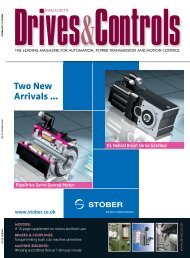New Danfoss VLT® Decentral Drive E cient, reliable and powerful
New Danfoss VLT® Decentral Drive E cient, reliable and powerful
New Danfoss VLT® Decentral Drive E cient, reliable and powerful
You also want an ePaper? Increase the reach of your titles
YUMPU automatically turns print PDFs into web optimized ePapers that Google loves.
PLCs AND HMIs<br />
What can HMIs learn<br />
from the iPhone?<br />
What are latest trends in HMIs <strong>and</strong> what should you look<br />
for when choosing one? Dirk Hartmann, marketing<br />
manager for Beijer Electronics, outlines some key trends.<br />
HMIs are in a state of flux. Industrial<br />
user interfaces are taking inspiration<br />
from consumer products such as<br />
mobile phones <strong>and</strong> MP3 players, with<br />
advanced 3D-style graphics <strong>and</strong> icon-based<br />
navigation <strong>and</strong> controls, resulting in friendly<br />
<strong>and</strong> intuitive user interfaces. Leading-edge<br />
HMIs support this with embedded graphics<br />
<strong>and</strong> functions, providing intuitive user<br />
interfaces based on modern software<br />
technologies <strong>and</strong> open architectures.<br />
Trend 1: Enhancing the user experience<br />
The significance of user interfaces has<br />
become increasingly clear in recent years.<br />
For example, Apple’s iPod <strong>and</strong> iPhone are<br />
iconic examples of how appealing <strong>and</strong><br />
intuitive user interfaces have changed the<br />
perception of some types of product. The<br />
success of these products <strong>and</strong> other<br />
consumer-oriented merch<strong>and</strong>ise shows that<br />
a common look-<strong>and</strong>-feel among the<br />
products, graphics <strong>and</strong> environments<br />
contributes to br<strong>and</strong> distinction <strong>and</strong> to<br />
consistent customer experiences.<br />
Many industrial corporations have<br />
reached the same conclusion <strong>and</strong> are<br />
focussing increasingly on their products’<br />
user interfaces. In many ways, the HMI is<br />
the front of a machine or process. The<br />
higher the level of functionality <strong>and</strong><br />
interaction embedded in an HMI, the more<br />
the user interface reflects the essential<br />
experience of a machine or process.<br />
Tomorrow’s HMIs will elevate the HMI from<br />
being a functional add-on, to becoming an<br />
integral part of a user experience.<br />
Design features will include the use of<br />
WPF (Windows Presentation Foundation)<br />
objects, scalable to any size without losing<br />
picture quality, <strong>and</strong> the use of Microsoft<br />
.Net objects found or bought on the<br />
Internet. The use of templates <strong>and</strong> object<br />
styles will facilitate effi<strong>cient</strong> ways to ensure<br />
consistent, re-usable designs. Embedding<br />
functional objects, including Windows<br />
media objects, in the screen design will<br />
further enhance the user experience.<br />
In addition to the competitive advantages<br />
for machine-builders, there are solid<br />
arguments for end-users to justify investing<br />
in well-designed, intuitive user interfaces.<br />
The added value of tomorrow’s HMIs will<br />
be reflected in ease of use, higher efficiency<br />
<strong>and</strong> productivity, reduced time to complete<br />
tasks, improved user satisfaction, trust in<br />
the systems, <strong>and</strong> fewer user errors.<br />
Trend 2: Innovation based on modern<br />
software technologies<br />
The evolution of HMIs is being driven by<br />
continuous software development, backed<br />
by robust, high-performance hardware.<br />
Today, the panel is considered as a vehicle<br />
for the HMI software platform, allowing<br />
OEM design engineers to add value to their<br />
products with various functions <strong>and</strong> design<br />
options. The software platform is therefore<br />
a crucial element.<br />
HMI software development is costly <strong>and</strong><br />
complex. Innovative HMI manufacturers<br />
need to base their software platforms on<br />
widely-used modern technologies to access<br />
a broad variety of tools <strong>and</strong> functions.<br />
For example, the resources behind the<br />
.Net technology are enormous, <strong>and</strong> this will<br />
be reflected in the continuous development<br />
of new HMI functions. Dependence on<br />
proprietary technologies or technologies<br />
from smaller vendors is a risky strategy.<br />
HMIs based on .Net or similar<br />
technologies are likely to deliver innovative,<br />
future-proof tools with continuous updates<br />
<strong>and</strong> service support, appreciated by OEMs<br />
with long-term strategies for their own<br />
products <strong>and</strong> external suppliers.<br />
Trend 3: Open platform architectures<br />
Essentially, HMIs integrate the operation of<br />
a machine or a process with feedback to or<br />
from the operator. A key aspect is the<br />
openness of the HMI system. How easy is it<br />
to exchange essential information with<br />
different systems or controllers? Is the<br />
application code locked for customisation<br />
of functions or objects? Will runtime<br />
software be able to operate on different<br />
hardware platforms? Increasingly, HMI<br />
vendors are discussing these issues with<br />
their customers.<br />
The open platform architecture of<br />
tomorrow’s HMIs will offer opportunities<br />
for OEMs to enhance the look, functions<br />
<strong>and</strong> connectivity of applications to produce<br />
unique products. HMIs, from compact<br />
operator panels to industrial PCs, will<br />
become less proprietary <strong>and</strong> will offer<br />
increased freedom of choice.<br />
It will be possible to create a scalable<br />
master project, which can be applied to<br />
different controller br<strong>and</strong>s <strong>and</strong> panel<br />
resolutions, thus needing to maintain only<br />
one project. Engineers will dem<strong>and</strong><br />
opportunities to use scripting tools, such as<br />
C++ script, to customise the look or<br />
functions of objects. Design tools will offer<br />
the possibility of importing third-party<br />
objects <strong>and</strong> .Net controls.<br />
Freedom in terms of connections <strong>and</strong><br />
communications is the hallmark of truly<br />
open HMIs <strong>and</strong> covers options from simple<br />
real-time exchange of data between<br />
controllers, up to SQL <strong>and</strong> OPC<br />
communications with other equipment <strong>and</strong><br />
IT systems.<br />
User interfaces do not need advanced<br />
graphics. Simplicity <strong>and</strong> consistency often<br />
beat complexity <strong>and</strong> overly artistic systems.<br />
However, the design process often benefits<br />
from co-operation between graphic<br />
designers <strong>and</strong> application engineers.<br />
D&C<br />
44 November/December 2010 www.drives.co.uk




